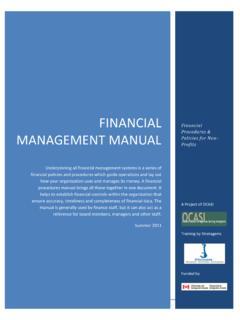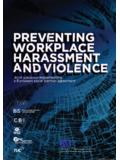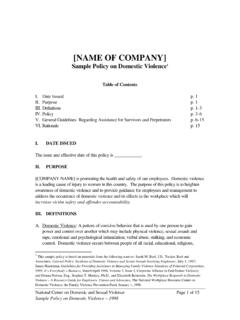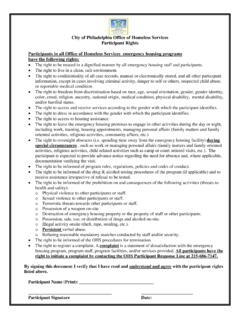Transcription of Managing Board Conflict - OrgWise
1 2003 Non-Profit Sector Leadership Program, Dalhousie University Page 1 Participating as a member of a Board of directors of a voluntary organization is one of the most important ways we can be active in a democracy. Indeed, many people feel that democracy is about active citizenship and that voting on who should represent us in government is only part of what is required of us. Volunteer boards offer an intimate experience for participating in public life. They call upon our intellect, our deepest beliefs and our skills. Strengthening an inner-city neighbourhood, preserving the natural environment, promoting children s sports, and helping people in need is all important work.
2 It depends on discussion, debate and ultimately collective action. Wherever people with strong convictions work together to make a difference, there will be Conflict . Individual voices have to give way to the voice of the group. Conflict is competition between and among individuals. It can be constructive and stimulating. It promotes change and adaptation. Conflict , managed well, can promote awareness of self and others. It can even strengthen relationships and heighten morale. Conflict can be destructive too, and it is its ability to damage individuals and relationships that too often confronts and confounds us. Community organizations and their boards of directors can be fertile ground for Conflict because they tend to: Be diverse in their membership Involve passionate people.
3 Struggle with being unified in their organizational mission and goals in the face of many demands Be an expression of alternative democratic structures and processes: non-authoritarian, non- hierarchical and inclusive. Involve shared leadership with key roles being played by the Board and the Executive Director. Managing Board Conflict by E. Grant MacDonald, Director Non-Profit Sector Leadership Program Managing Board Conflict 2003 Non-Profit Sector Leadership Program, Dalhousie University Page 2 Operate in a dynamic, frequently adversarial, political environment Your Board s Conflict Handling Culture A Board of directors will, at any point in its history, be located somewhere on a spectrum of Managing Conflict , a spectrum that depicts the extremes and the spaces between them.
4 One way of describing this is indicated below: The Passive Board In the above model, the passive Board is the Board that is going through the motions of governance. Directors see themselves as advisors and operate as a rubber stamp in approving the decisions of those few who are really in charge. The passive Board is a group content with the status quo, complacent, comfortable being led by an influential person (perhaps the founder, Chair of Board or the Executive Director). The passive Board is one that may be characterized by poor attendance, little membership turnover, very few vocal persons. The passive Board is one that takes as given to them, both the ends and means of the organization.
5 When a Board s orientation to the world is passive, the governance work of the organization will be done by staff. The Embattled Board At another extreme is the embattled Board . This is the Board so involved in power plays and direct and/or behind the scenes politics that it has no time to provide leadership. It is likely a Board that regards the governance role as an important one, but the directors and even staff are likely at odds over ends, means and values. If it is a representative Board , Conflict may arise over how the resources or benefits are divided amongst various constituencies. An embattled Board may be divided into factions, some of whom will be involved in secret meetings.
6 Also, it is a Board where the differences between its members will spill out from broad meetings to draw staff members and maybe even clients into the fray. Embattled boards are often those subject to pressures from outside the organization that serve to accentuate the Conflict rather than bringing people together in common cause. The Harmonious Board The ideal is the harmonious Board , the Board where different voices blend to create a beautiful sound. It is a Board that has assumed ownership over the ends of the organization, although not necessarily the means. The Board sees itself as a team with each person making a unique PASSIVE Board EMBATTLED Board HARMONIOUS Board Managing Board Conflict 2003 Non-Profit Sector Leadership Program, Dalhousie University Page 3 contribution.
7 It is a Board prepared to take on new challenges and risks. The Board takes a lot of responsibility for Managing itself; new members are welcomed, encouraged and supported. Most boards will find themselves in various places in this spectrum throughout the life of their organization. Although the harmonious Board might be the ideal and the passive Board and embattled Board are to be avoided, depending on the circumstances and people involved, other locations in the spectrum might be the right place to be. Conflict s Many Guises Where Conflict exists, it will tend to manifest itself in different ways. Direct Conflict Sometimes our disagreements are out in the open, Conflict is up-front, different points of view are on the table.
8 People are arguing, taking stands, trying to persuade one another, or agreeing to disagree. The mood may be one of anger, frustration or excitement. People may be behaving respectively towards one another, or the debate may involve personal attacks, name calling or shouting. Confronting differences openly has the potential for the most positive outcomes. Subtle or Silent Conflict Conflict can often be subtle; it can exist more in what is not said than what is said. Conflict frequently goes unacknowledged by one or more of the parties and unnoticed or avoided by others. Subtle Conflict often occurs where a Board is dominated by one person or a small group.
9 It can manifest itself in withdrawal, silence, manipulation, poor attendance and resignation. Circular Conflict Circular Conflict involves a continual and often escalating range of both deliberate and unconscious actions by individuals that frustrate the ability of the Board as a whole to get to the heart of a problem. Boards that are divided into factions can find themselves operating in a circular mode of Conflict . In Keeping The Peace (2000), Marion Peters Angelica describes this as spiraling Conflict and suggests that it often takes someone new to the situation to see it. Violent Conflict Violence, whether physical or psychological, can be present in community organizations, as it can in other aspects of life.
10 Violence or threats of violence ought to be taken very seriously by boards of directors. Consideration should be given to involving the police. Behind the Conflict We are often very quick to explain our differences as personality conflicts , but most conflicts are more complex than differences in personal style or types. One of the secrets to Managing Conflict is to understand its various sources. Managing Board Conflict 2003 Non-Profit Sector Leadership Program, Dalhousie University Page 4 Christopher Moore has identified five sources or kinds of Conflict and suggests that in most difficult situations more than one is involved. Understanding these sources can help us in knowing what interventions we can make to prevent the Conflict from being destructive.














